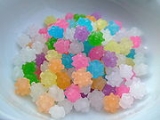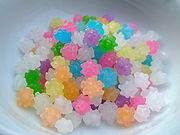
Kompeito
Encyclopedia

Kanji
Kanji are the adopted logographic Chinese characters hanzi that are used in the modern Japanese writing system along with hiragana , katakana , Indo Arabic numerals, and the occasional use of the Latin alphabet...
, or こんぺいとう, コンペイトー in kana
Kana
Kana are the syllabic Japanese scripts, as opposed to the logographic Chinese characters known in Japan as kanji and the Roman alphabet known as rōmaji...
, konpeitō) is a Japanese
Japan
Japan is an island nation in East Asia. Located in the Pacific Ocean, it lies to the east of the Sea of Japan, China, North Korea, South Korea and Russia, stretching from the Sea of Okhotsk in the north to the East China Sea and Taiwan in the south...
candy.
History
The word "konpeito" comes from the Portuguese word confeito, which means a sugar candyCandy
Candy, specifically sugar candy, is a confection made from a concentrated solution of sugar in water, to which flavorings and colorants are added...
. This technique for producing candy was introduced to Japan
Japan
Japan is an island nation in East Asia. Located in the Pacific Ocean, it lies to the east of the Sea of Japan, China, North Korea, South Korea and Russia, stretching from the Sea of Okhotsk in the north to the East China Sea and Taiwan in the south...
in the early 16th century by Portuguese
Portugal
Portugal , officially the Portuguese Republic is a country situated in southwestern Europe on the Iberian Peninsula. Portugal is the westernmost country of Europe, and is bordered by the Atlantic Ocean to the West and South and by Spain to the North and East. The Atlantic archipelagos of the...
traders. The infrastructure and refining technology of sugar had not yet been established in Japan in those days. As konpeito uses a lot of sugar, it was very rare and expensive as a result. In 1569, Luís Fróis
Luís Fróis
Luís Fróis was a Portuguese missionary.He was born in Lisbon and in 1548 joined the Society of Jesus . In 1563, he came to Japan to engage in missionary work, and in the following year arrived in Kyoto, meeting Ashikaga Yoshiteru who was then Shogun...
, a Portuguese missionary, presented a flask of konpeito to Oda Nobunaga
Oda Nobunaga
was the initiator of the unification of Japan under the shogunate in the late 16th century, which ruled Japan until the Meiji Restoration in 1868. He was also a major daimyo during the Sengoku period of Japanese history. His opus was continued, completed and finalized by his successors Toyotomi...
in order to obtain the permit for mission work of Christianity
Christianity
Christianity is a monotheistic religion based on the life and teachings of Jesus as presented in canonical gospels and other New Testament writings...
.
In Meiji period, konpeito had already been culturally-prescribed as one of the standards of Japanese sweets - the character Sugar Plum Fairy in the Nutcracker
The Nutcracker
The Nutcracker is a two-act ballet, originally choreographed by Marius Petipa and Lev Ivanov with a score by Pyotr Ilyich Tchaikovsky. The libretto is adapted from E.T.A. Hoffmann's story "The Nutcracker and the Mouse King". It was given its première at the Mariinsky Theatre in St...
was translated into konpeito no sei . Konpeito is also the standard of the thank-you-for-coming gift which is given by the Imperial House of Japan
Imperial House of Japan
The , also referred to as the Imperial Family or the Yamato Dynasty, comprises those members of the extended family of the reigning Emperor of Japan who undertake official and public duties. Under the present Constitution of Japan, the emperor is the symbol of the state and unity of the people...
. The gift is not called konpeito but pomponiere including the top case.

